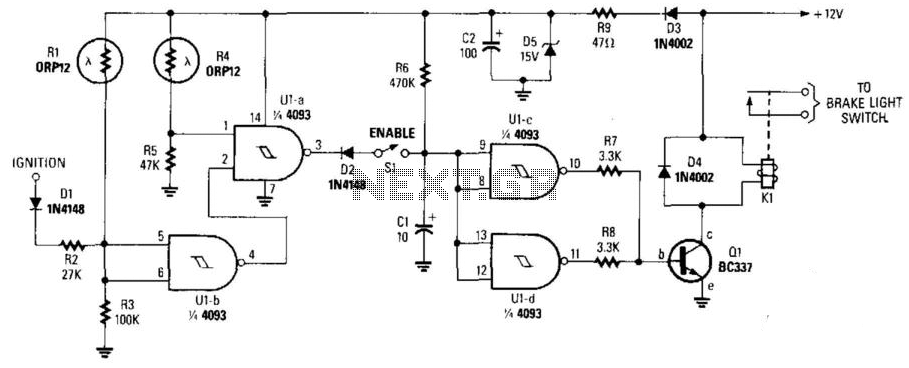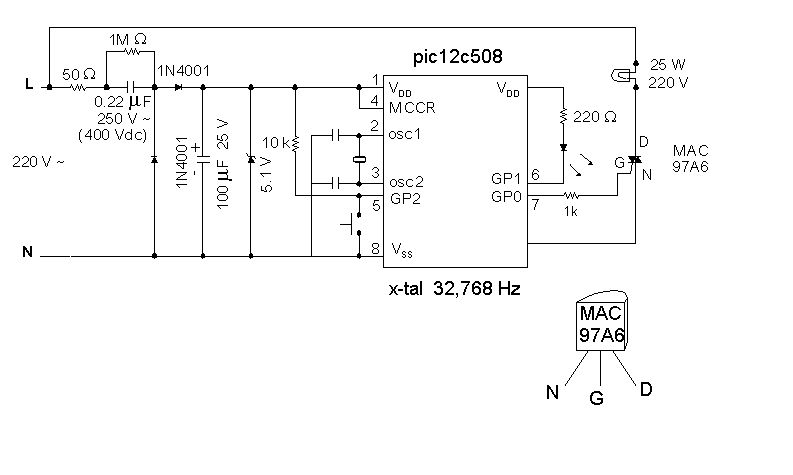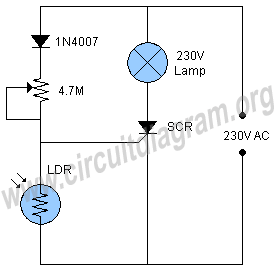
Night Alert

The concept for this circuit originated when a pet dog began barking persistently upon detecting a moving shadow, possibly that of an intruder. Dogs possess a night adaptation capability that enhances their vision sensitivity in low-light conditions, allowing them to detect moving objects more effectively than stationary ones in darkness. This circuit activates a lamp for a brief period when the dog barks, creating the impression that the occupants have been alerted. A condenser microphone installed in the dog's cage detects the barking sound and generates AC signals, which pass through a DC blocking capacitor (C1) to the base of transistor BC549 (T1). Transistor T1, along with transistor T2, amplifies the sound signals and provides current pulses from the collector of T2. The input trigger pulse is applied to the collector of transistor T3 and coupled via capacitor C3 to the base of transistor T4, causing T4 to turn off. The collector voltage of transistor T4 forward biases transistor T3 through resistor R8. When transistor T1 conducts, capacitor C3 discharges, keeping transistor T4 off. Transistor T4 remains off until capacitor C3 charges sufficiently to allow it to conduct. When transistor T4 conducts, its collector voltage drops, driving transistor T3 into a cutoff state. Resistor R9 and capacitor C3 serve as timing components, with capacitor C3 taking approximately two minutes to discharge when fully charged. Thus, when sound is detected by the condenser microphone, TRIAC1 (BT136) is triggered, causing bulb B1 to illuminate for about two minutes. The circuit should be assembled on a general-purpose PCB and enclosed in a plastic cabinet. Power can be supplied by a 12V, 500mA step-down transformer with a rectifier and smoothing capacitor. The TRIAC should be soldered with adequate spacing between the pins to prevent short circuits. The unit can be placed in the dog's cage, with the lamp positioned either inside or outside as preferred. The microphone should be connected to the circuit using a short length of shielded wire and enclosed in a tube to enhance its sensitivity. Caution is advised as the circuit operates at 230V AC, with many components exposed to mains voltage, posing a risk of electric shock. Individuals unfamiliar with handling line voltages should refrain from constructing this circuit, as EFY disclaims any responsibility for potential losses or damages.
This circuit is designed to function as an alert system, leveraging the natural behavior of dogs to detect movement and sound. The use of a condenser microphone allows for sensitive sound detection, ensuring that even quiet barking is captured effectively. The amplification stage, comprising transistors T1 and T2, is crucial for processing the audio signals, transforming them into sufficient electrical pulses capable of triggering the TRIAC.
The timing mechanism incorporated through resistor R9 and capacitor C3 is essential for determining the duration of the lamp's illumination. This two-minute delay not only provides a realistic visual alert but also conserves energy by ensuring the lamp does not remain on indefinitely. The choice of a TRIAC for controlling the lamp allows for efficient switching of the AC load, ensuring reliable operation.
Safety measures are paramount due to the high voltage operation of the circuit. The recommendation to use shielded wiring for the microphone connection minimizes interference and enhances signal integrity, while the enclosure serves to protect the circuit from external environmental factors and accidental contact with live components.
Overall, this circuit exemplifies a practical application of basic electronic components to create a functional and responsive alert system, suitable for enhancing security in environments where pets are present. Proper assembly and adherence to safety guidelines are critical for successful implementation.Idea of this circuit came to me at midnight when my pet dog started barking continuously on sensing a moving shadow, perhaps that of an intruder. Dogs have a night adaptation capability to maximise the sensitivity of vision in low light. They are well adapted to see moving objects rather than stationary ones in darkness. This circuit turns a lamp on` for a short duration when the dog barks, giving an impression that the occupants have been alerted. The condenser microphone fitted in the dog`s cage senses barking sound and generates AC signals, which pass through DC blocking capacitor C1 to the base of transistor BC549 (T1).
Transistor T1 along with transistor T2 amplifies the sound signals and provides current pulses from the collector of T2. The input trigger pulse is applied to the collector of transistor T3 and coupled by capacitor C3 to the base of transistor T4 causing T4 to cut off.
The collector voltage of transistor T4 forward biases transistor T3 via resistor R8. Transistor T1 conducts and capacitor C3 discharges to keep transistor T4 cut-off. Transistor T4 remains cut-off until capacitor C3 charges enough to enable it to conduct. When transistor T4 conducts, its collector voltage goes low to drive transistor T3 into cut-off state. Resistor R9 and capacitor C3 are timing components. When fully charged, capacitor C3 takes about two minutes to discharge. So when sound is produced in front of the condenser mic, TRiAC1 (BT136) fires and the bulb (B1) glows for about two minutes.
Assemble the circuit on a general-purpose PCB and enclose in a plastic cabinet. Power to the circuit can be derived from a 12V, 500mA step-down transformer with rectifier and smoothing capacitor. Solder the triac ensuring sufficient spacing between the pins to avoid short circuit. Fix the unit in the dog`s cage, with the lamp inside or outside as desired. Connect the microphone to the circuit using a short length of shielded wire. Enclose the microphone in a tube to increase its sensitivity. Since the circuit uses 230V AC, many of its points are at AC mains voltage. it could give you lethal shock if you are not careful. So if you don`t know much about working with line voltages, do not attempt to construct this circuit.
EFY will not be responsible for any kind of resulting loss or damage. 🔗 External reference
This circuit is designed to function as an alert system, leveraging the natural behavior of dogs to detect movement and sound. The use of a condenser microphone allows for sensitive sound detection, ensuring that even quiet barking is captured effectively. The amplification stage, comprising transistors T1 and T2, is crucial for processing the audio signals, transforming them into sufficient electrical pulses capable of triggering the TRIAC.
The timing mechanism incorporated through resistor R9 and capacitor C3 is essential for determining the duration of the lamp's illumination. This two-minute delay not only provides a realistic visual alert but also conserves energy by ensuring the lamp does not remain on indefinitely. The choice of a TRIAC for controlling the lamp allows for efficient switching of the AC load, ensuring reliable operation.
Safety measures are paramount due to the high voltage operation of the circuit. The recommendation to use shielded wiring for the microphone connection minimizes interference and enhances signal integrity, while the enclosure serves to protect the circuit from external environmental factors and accidental contact with live components.
Overall, this circuit exemplifies a practical application of basic electronic components to create a functional and responsive alert system, suitable for enhancing security in environments where pets are present. Proper assembly and adherence to safety guidelines are critical for successful implementation.Idea of this circuit came to me at midnight when my pet dog started barking continuously on sensing a moving shadow, perhaps that of an intruder. Dogs have a night adaptation capability to maximise the sensitivity of vision in low light. They are well adapted to see moving objects rather than stationary ones in darkness. This circuit turns a lamp on` for a short duration when the dog barks, giving an impression that the occupants have been alerted. The condenser microphone fitted in the dog`s cage senses barking sound and generates AC signals, which pass through DC blocking capacitor C1 to the base of transistor BC549 (T1).
Transistor T1 along with transistor T2 amplifies the sound signals and provides current pulses from the collector of T2. The input trigger pulse is applied to the collector of transistor T3 and coupled by capacitor C3 to the base of transistor T4 causing T4 to cut off.
The collector voltage of transistor T4 forward biases transistor T3 via resistor R8. Transistor T1 conducts and capacitor C3 discharges to keep transistor T4 cut-off. Transistor T4 remains cut-off until capacitor C3 charges enough to enable it to conduct. When transistor T4 conducts, its collector voltage goes low to drive transistor T3 into cut-off state. Resistor R9 and capacitor C3 are timing components. When fully charged, capacitor C3 takes about two minutes to discharge. So when sound is produced in front of the condenser mic, TRiAC1 (BT136) fires and the bulb (B1) glows for about two minutes.
Assemble the circuit on a general-purpose PCB and enclose in a plastic cabinet. Power to the circuit can be derived from a 12V, 500mA step-down transformer with rectifier and smoothing capacitor. Solder the triac ensuring sufficient spacing between the pins to avoid short circuit. Fix the unit in the dog`s cage, with the lamp inside or outside as desired. Connect the microphone to the circuit using a short length of shielded wire. Enclose the microphone in a tube to increase its sensitivity. Since the circuit uses 230V AC, many of its points are at AC mains voltage. it could give you lethal shock if you are not careful. So if you don`t know much about working with line voltages, do not attempt to construct this circuit.
EFY will not be responsible for any kind of resulting loss or damage. 🔗 External reference





